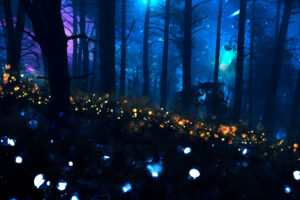Prepare to be transported to a world where fairy tales seem tangible, and the echoes of the past live on in stone and mortar. These castles, with their imposing fortifications, delicate spires, and intricate masonry, continue to captivate the imagination of visitors from around the globe. Without further ado, let us venture into the realms of kings and queens, knights and legends, to explore the top 26 most beautiful castles in the world.
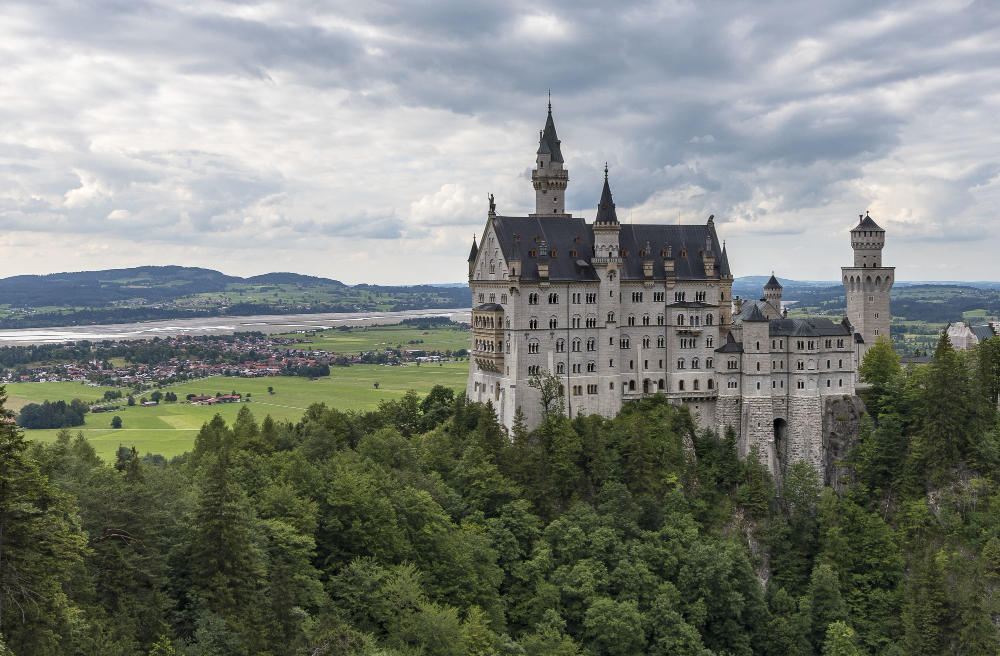
Image by wirestock on Freepik
Table of Contents
1. Jaisalmer Fort, Jaisalmer, Rajasthan
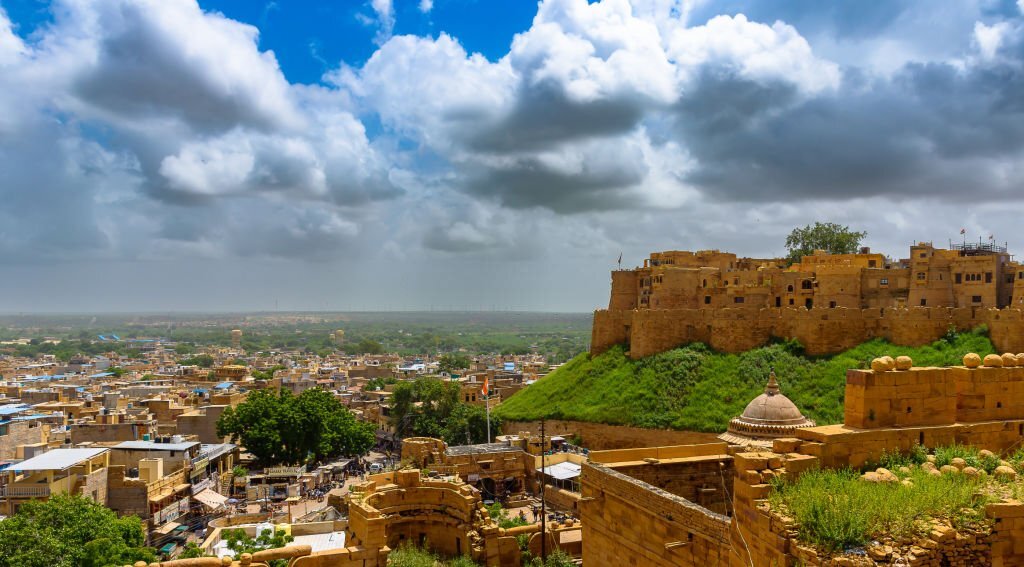
Image by WanderOn
Known as the ‘Sonar Qila’ or Golden Fort due to its yellow sandstone walls that glow golden at sunset, Jaisalmer Fort is one of the few living forts in the world. With its 99 bastions, intricate Rajasthani architecture, and homes and temples within its massive walls, it offers a unique glimpse into royal life of the past.
Jaisalmer Fort, located in the heart of the Thar Desert in Rajasthan, India, stands as a magnificent testament to the rich history and architectural brilliance of the region. Known as the ‘Golden Fort’ or ‘Sonar Qila,’ its massive yellow sandstone walls glisten like gold under the sun, creating a mesmerizing sight. Built in 1156 AD by the Rajput ruler Rawal Jaisal, from whom the fort and the city derive their names, Jaisalmer Fort is one of the very few living forts in the world, with about a quarter of the city’s population still residing within its walls.
The fort’s imposing structure encompasses palaces, temples, residential complexes, and narrow lanes, all exuding an aura of a bygone era. The Raj Mahal (Royal Palace), Jain temples dating back to the 12th to 15th centuries, and the Laxminath temple are among the remarkable structures within the fort. The intricately carved facades, jharokhas (balconies), and the lattice work showcase the craftsmanship of the Rajasthani artisans.
Not just a static monument, Jaisalmer Fort is alive with shops, hotels, and eateries, offering visitors a glimpse into the living heritage of the region. Its strategic position on the camel trade routes added to the fort’s historical importance, making it a crucial hub of commerce in the past. Today, it stands as a UNESCO World Heritage Site, drawing tourists from across the globe who come to marvel at its beauty and delve into its rich history.
2. Neuschwanstein Castle, Germany
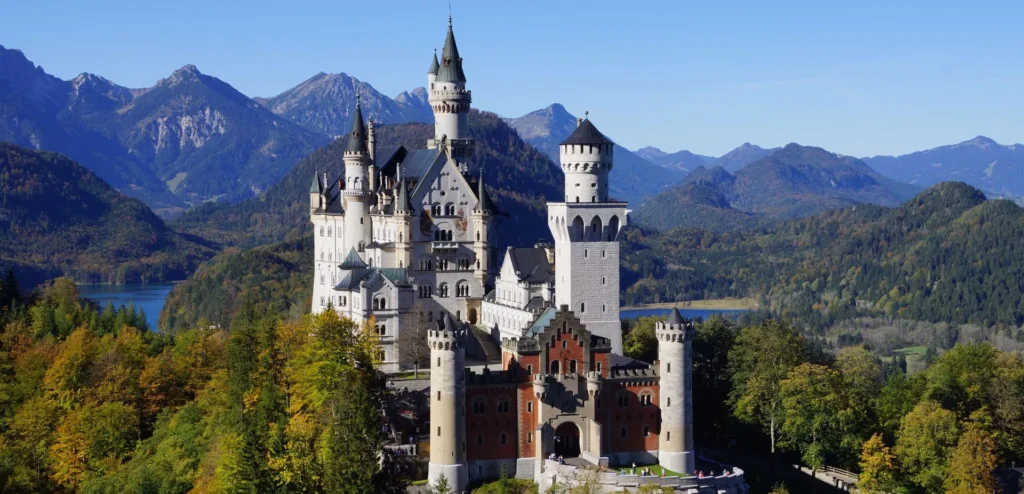
Image by Hohenschwangau
Nestled in the Bavarian Alps, this iconic castle served as the inspiration for Disney’s Sleeping Beauty castle. Its picturesque setting and fairy-tale look make it a must-see.
Neuschwanstein Castle, nestled in the majestic Bavarian Alps of Germany, is the epitome of fairy-tale architecture and enchantment. Built in the late 19th century by Ludwig II of Bavaria, the castle was intended as a personal refuge for the reclusive king, yet it has become one of the most visited and recognizable castles in the world. Its Romanesque Revival design, with slender towers and delicate turrets soaring into the sky, encapsulates the essence of romanticism and fantasy.
The castle’s location is as breathtaking as its design, with rugged cliffs and pristine forests providing a stunning backdrop that enhances its mystique and beauty. Inside, Neuschwanstein is equally impressive, with lavish interiors that include the Throne Room, Singers’ Hall, and intricate murals depicting legends and tales that were dear to King Ludwig II.
It’s no wonder that Neuschwanstein Castle inspired Walt Disney to create the Sleeping Beauty Castle, an image that has become synonymous with fairy tales and magic around the globe. Visiting Neuschwanstein offers a unique opportunity to step into a world where fantasy feels like reality, making it a must-see destination for anyone captivated by the allure of fairy tales and spectacular scenery. Its timeless charm continues to dazzle, leaving an indelible mark on the hearts of all who witness its splendor.
3. Mont Saint-Michel, France

Image by EnjoyTravel
This fortress is perched on a rocky island in Normandy and offers a dramatic blend of natural beauty and architectural marvel, enticing visitors from around the globe.
Mont Saint-Michel, located in Normandy, France, stands as an iconic representation of the seamless blend between nature’s grandeur and human architectural achievement. Perched majestically on a rocky island, this fortress is a visual spectacle that seems to rise ethereally out of the waters of the surrounding bay. Its unique setting, accessible only at low tide, historically served both as a means of natural defense and as a symbol of divine inspiration. Over the centuries, Mont Saint-Michel has attracted pilgrims, tourists, and history enthusiasts drawn to its mystical ambiance and rich past.
The architectural splendor of Mont Saint-Michel is a testament to the ingenuity of medieval construction. The stronghold is crowned by the magnificent abbey, which towers over the landscape—a beacon of medieval Gothic architecture. The winding streets below, lined with ancient buildings, invite visitors to step back in time and explore the historical richness of the island. Each stone and spire tells a story, from religious devotion to military resilience.
Mont Saint-Michel also captivates visitors with its breathtaking natural beauty. The ever-changing tides transform the landscape dramatically, distinguishing it as a place where the forces of nature and human history are intricately intertwined. As the tide ebbs and flows, Mont Saint-Michel alternates between being an island and a peninsula, offering constantly shifting perspectives that continue to enchant photographers and nature lovers alike.
This fortress is more than just a monument; it is a living testament to the enduring allure of the medieval world, inviting onlookers from across the globe to marvel at its beauty and dive into its depths of history. Mont Saint-Michel is not merely a destination; it is an experience, timeless and universal, beckoning to all who seek to witness the enduring magic of human achievement in harmony with the natural world.
4. Edinburgh Castle, Scotland
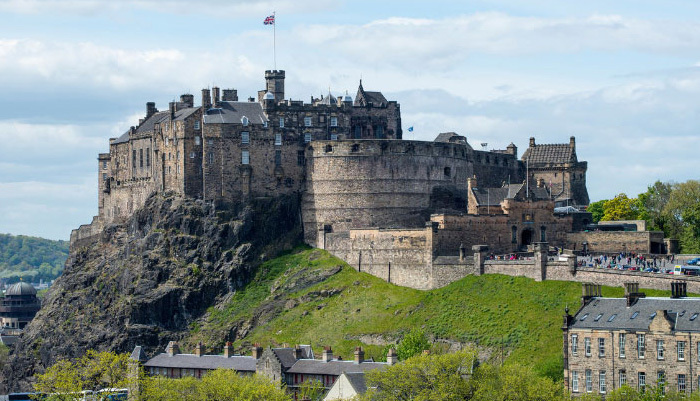
Image by Go Scotland Tours
Dominating the skyline of Edinburgh, this historic fortress is a symbol of Scottish pride and offers breathtaking views of the city.
Edinburgh Castle, standing majestically atop Castle Rock, is not merely a fortress but a living narrative of Scotland’s past. Its strategic position, dominating Edinburgh’s skyline, has made it a pivotal site throughout Scottish history. The castle’s origins are ancient, dating back to the Iron Age, but it was during the Middle Ages that it began to emerge as a royal residence and a military stronghold. As a symbol of Scottish pride, the castle has withstood numerous sieges and battles, playing a crucial role in the Wars of Scottish Independence. Its walls and buildings, each echoing centuries of history, include the Crown Jewels of Scotland and the Stone of Destiny — historically used in the coronation of Scottish monarchs.
Visitors to Edinburgh Castle are not only transported through time but are also treated to breathtaking views of the city below. From its ramparts, one can gaze upon the modern city juxtaposed against the backdrop of the sprawling landscape that defines this region of Scotland. This view not only encapsulates the essence of Edinburgh’s beauty but also allows visitors to understand the strategic importance of the castle’s location. The experience of standing atop Castle Rock, where history and present converge, is a powerful reminder of Scotland’s enduring heritage and the unbreakable spirit of its people.
5. Pena Palace, Portugal
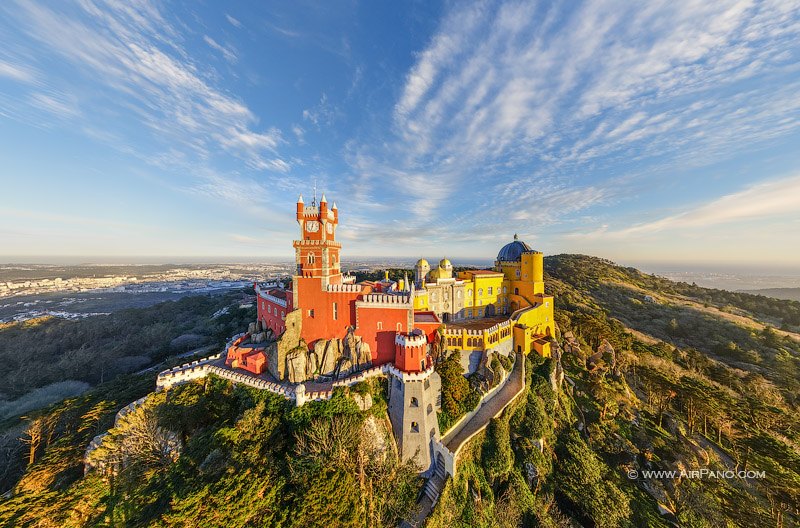
Image by AirPano
Colorful, extravagant, and perched atop a hill in Sintra, Pena Palace is a Romanticist masterpiece that looks like it’s straight out of a fantasy.
Pena Palace, perched atop the Sintra Mountains in Portugal, is a remarkable testament to 19th-century Romanticism. Its vibrant colors and eclectic architectural styles distinguish it as one of Portugal’s most iconic landmarks. The palace was built by King Ferdinand II, who envisioned a castle where the grandeur of European royal residences would blend harmoniously with the wild, rugged landscapes of Sintra. As a result, Pena Palace is a fusion of Gothic, Renaissance, Moorish, and Manueline motifs, creating a visually stunning masterpiece that seems lifted from the pages of a fairy tale.
Surrounded by lush, forested grounds known as the Pena Park, the palace encapsulates a fantasy world of exotic plants, hidden paths, and captivating views of the countryside stretching towards the Atlantic Ocean. Its interiors are equally impressive, adorned with intricate stonework, ornate tiles, and period furniture, each room narrating a chapter of Portuguese royal history.
Visiting Pena Palace is a journey into the imagination of a king who dared to dream beyond the conventional, creating a unique heritage that enthralls visitors with its beauty and historical significance. Its position high above the town of Sintra offers an unparalleled panorama of the region, making it a must-visit destination for those seeking to marvel at the intersection of natural beauty and human creativity.
6. Alhambra, Spain
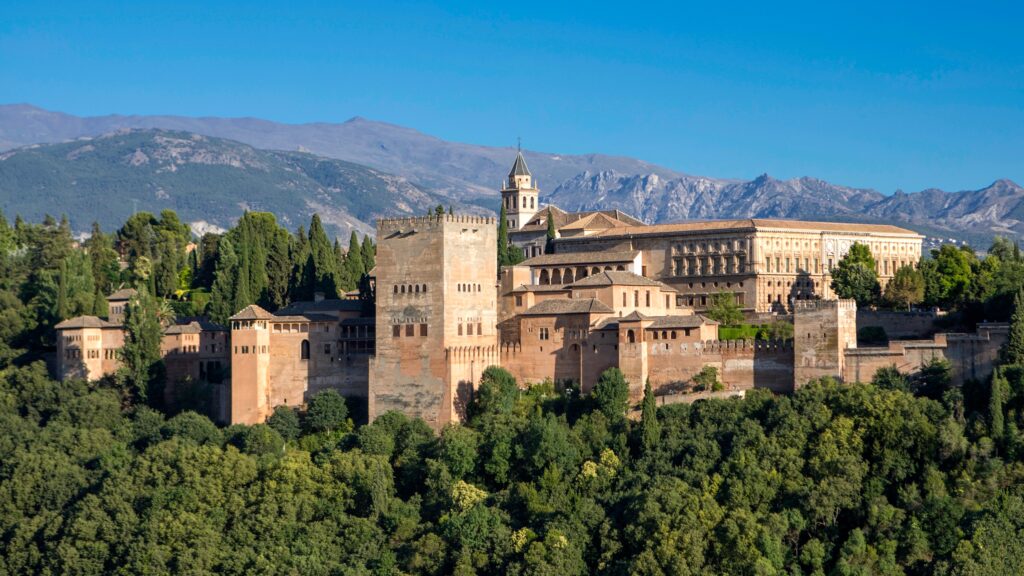
Image by www.history.com
A stunning example of Moorish architecture, this complex in Granada boasts exquisite gardens, intricate carvings, and mesmerizing tilework.
The Alhambra, located in Granada, Spain, stands as a majestic monument to the splendors of Moorish architecture and the rich cultural heritage of the Andalusian region. Built predominantly during the mid-14th century under the Nasrid Dynasty, this fortress-palace complex is a stunning representation of Islamic art and architectural prowess, showcasing intricate tile mosaics, elaborate stucco work, and iconic arches that evoke a sense of timeless elegance and sophistication.
Perched on the rolling hills of Al-Sabika, overlooking the city of Granada, the Alhambra seamlessly integrates with the natural landscape, its red-tinted walls blending with the Sierra Nevada’s backdrop. The complex is an intricate collection of buildings, gardens, and courtyards, each telling a story of its past glories, political intrigue, and artistic refinement. Notable areas include the Nasrid Palaces, with their breathtakingly beautiful rooms, and the Generalife, a villa with gardens that offer a tranquil escape, demonstrating the Islamic concept of paradise on earth.
Visiting the Alhambra is a journey through time, providing insight into the Muslim rule of Spain and the eventual Christian reconquest. It remains a testament to the coexistence of different cultures, offering lessons in architectural innovation, aesthetic beauty, and historical significance.
7. Himeji Castle, Japan
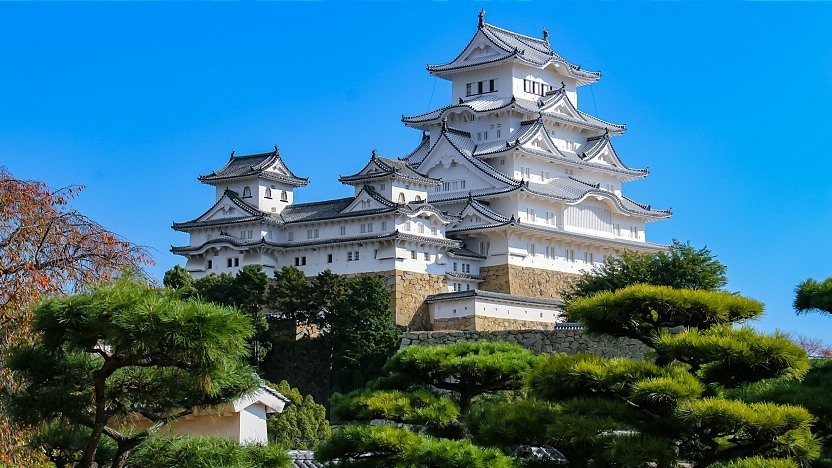
Image by www.history.com
Known as the “White Heron Castle” for its brilliant white exterior and elegant design, this is Japan’s most visited and preserved feudal castle.
Himeji Castle, located in Himeji, Japan, is an architectural masterpiece and a paramount example of Japanese castle design. Known affectionately as “White Heron Castle” due to its brilliant white exterior and graceful, bird-like appearance, it stands as a symbol of both the sophistication of Japanese feudal architecture and the country’s rich historical narrative. Constructed in the early 17th century during the Edo period, this UNESCO World Heritage site has remarkably survived the test of time, including natural disasters and war, virtually intact.
The castle’s design is a strategic masterpiece, featuring a complex network of 83 buildings connected by a series of gates, walls, and winding paths designed to confuse and slow the advance of enemies. Its main keep, which rises majestically above the surrounding landscape, provides not only a powerful military fortification but also unparalleled views of the city and beyond. The ingenuity of Himeji Castle’s construction, particularly its defensive mechanisms, and its aesthetic beauty, characterized by contrasting white plaster and dark wood, make it a must-visit destination for those interested in Japanese history, culture, and architecture.
8. Château de Chambord, France

Image by GetYourGuide
The largest château in the Loire Valley, Chambord is a Renaissance masterpiece known for its distinctive French architecture and vast parklands.
Château de Chambord, nestled in the heart of the Loire Valley, France, is a monumental symbol of the Renaissance era’s grandeur and architectural innovation. Commissioned by King François I in 1519, this French Renaissance masterpiece was intended as a hunting lodge and a demonstration of royal power and prestige. Its design, attributed to Domenico da Cortona with contributions from Leonardo da Vinci, showcases a perfect blend of traditional medieval forms with classical Italian Renaissance structures.
The chateau’s most striking feature is its intricate and innovative double helix staircase, believed to be influenced by da Vinci. This architectural marvel sits at the core of the building, allowing two people to ascend and descend without ever meeting, embodying the spirit of the Renaissance’s fascination with mystery and design.
Château de Chambord is distinguished by its expansive size, with a staggering 426 rooms, 282 fireplaces, and 77 staircases. Its silhouette is equally impressive, characterized by a forest of chimneys, spires, gables, and lanterns that rise above the massive structure, making it recognizable worldwide. The chateau is surrounded by a vast 5,440-hectare wooded park, enclosed by a 32-kilometer wall, making it the largest enclosed forest park in Europe.
Today, Château de Chambord stands as a testament to the ambition and creativity of the French Renaissance, attracting visitors from across the globe to marvel at its beauty and architectural complexity.
9. Windsor Castle, England
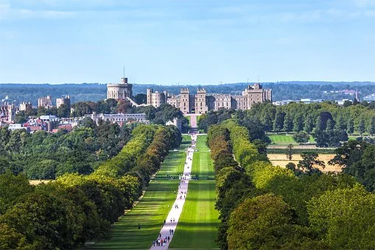
Image by GetYourGuide
As the oldest and largest occupied castle in the world, Windsor is an official residence of the Queen and a pinnacle of British heritage.
Windsor Castle, England, stands as a monumental beacon of British history and royal tradition. Located in the county of Berkshire, it has the distinction of being the oldest and largest inhabited castle in the world. Founded by William the Conqueror in the 11th century, it has been the residence of British monarchs for over 900 years, serving as an enduring symbol of the monarchy’s continuity and strength.
The castle’s sprawling complex encompasses approximately 13 acres, featuring a stunning mix of architectural styles that testify to the various epochs it has witnessed. The State Apartments form the centerpiece, adorned with invaluable artworks, including pieces by Rembrandt, Rubens, and Canaletto, reflecting its role as a royal palace and a guardian of the cultural heritage. St. George’s Chapel, another highlight, is a prime example of Gothic architecture, and the final resting place for ten monarchs, including Henry VIII and Charles I.
Windsor Castle is not just a relic of the past; it remains an active royal residence where Queen Elizabeth II spent many of her private weekends. It also plays host to ceremonial events, including state visits and the annual celebration of the Order of the Garter, Britain’s oldest order of chivalry.
Visitors to Windsor Castle can explore its opulent rooms, admire its exquisite art, and witness the traditional changing of the guard. This timeless fortress, steeped in history, continues to captivate and enchant, offering a unique glimpse into the United Kingdom’s rich and regal heritage.
10. Bodiam Castle, England

Image by Reddit
This 14th-century moated castle in East Sussex is one of the most picturesque and dreamy medieval castles in the world.
Bodiam Castle, nestled in East Sussex, England, is an iconic symbol of medieval architecture and history. Built in 1385 by Sir Edward Dalyngrigge, a former knight of Edward III, it served as a defense against French invasion during the Hundred Years’ War. This quadrangular castle, surrounded by a picturesque moat, boasts its original defensive elements: high battlements, a drawbridge, and a portcullis, encapsulating the essence of a 14th-century stronghold.
Its design is a stunning example of the transition from fortress to comfortable residence, reflecting the changing nature of English aristocracy. Inside the thick walls, the remains of chambers, halls, and the private apartments suggest a once-luxurious lifestyle, juxtaposed with its military purpose. Although now a ruin, Bodiam Castle still captures the imagination with its grandeur and historical significance.
Managed by the National Trust, it remains a major tourist attraction, drawing visitors from around the world eager to step back in time. The castle’s enchanting beauty, enhanced by its reflection on the moat’s surface, makes it a photographer’s paradise and an inspiration for artists. Beyond its physical allure, Bodiam Castle is a gateway to the medieval world, offering a tangible link to England’s storied past.
11. Prague Castle, Czech Republic
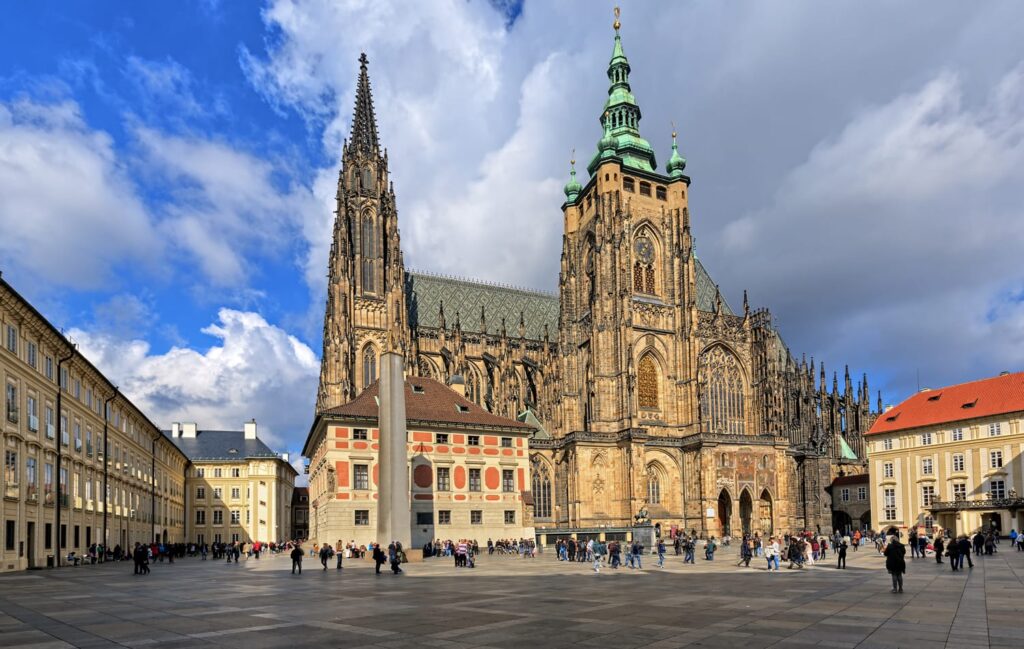
Image by Road Affair
Holding a record as the largest ancient castle in the world, this sprawling complex offers a blend of Gothic, Renaissance, and Romanesque architecture.
Prague Castle, perched majestically atop a hill overlooking the Vltava River in the Czech Republic, is a breathtaking complex that embodies the cultural and historical tapestry of Europe. Established in the 9th century, it has evolved through the ages, capturing the architectural essence of each era it has witnessed, making it one of the largest castle complexes in the world. The castle has been the seat of power for kings of Bohemia, Holy Roman emperors, and presidents of Czechoslovakia and the Czech Republic, symbolizing the enduring spirit and resilience of the Czech people.
The heart of this UNESCO World Heritage site is the awe-inspiring St. Vitus Cathedral, a masterpiece of Gothic architecture that houses the tombs of numerous saints and three Bohemian kings. The castle’s grounds also encompass serene gardens, stately courtyards, and prestigious buildings, including the Old Royal Palace, St. George’s Basilica, and the Golden Lane, each with its own unique story and architectural charm.
Prague Castle not only stands as a monument to architectural elegance and cultural heritage but also offers panoramic views of Prague, inviting visitors to explore its historical corridors, learn about its storied past, and experience the beauty and mystery that have captivated people for centuries.
12. Golconda Fort, Hyderabad
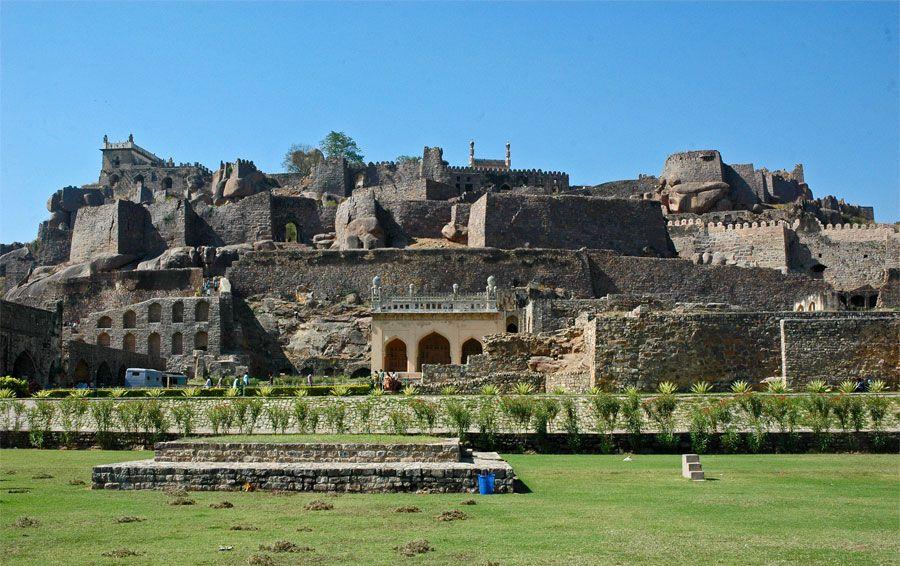
Image by India Tourism Guide
A fortified citadel and an early capital city of the Qutb Shahi dynasty, Golconda Fort is famous for its history intertwined with diamond trade. Its grandeur, architectural beauty, and ingenious acoustic signalling system are a marvel to explore.
Golconda Fort, a majestic monument located in Hyderabad, Telangana, India, stands as a testament to the region’s rich historical and architectural heritage. Originally built by the Kakatiya dynasty in the 12th century, it was later expanded by the Qutb Shahi kings, making it a formidable fortress and capital of the Golconda Sultanate. The fort’s architecture is a blend of Hindu and Islamic styles, showcasing intricate carvings, grand arches, and imposing gateways that narrate tales of bygone eras.
Nestled on a 120-meter-high granite hill, the fort’s complex includes eight gateways, numerous royal apartments and halls, temples, mosques, and about 87 semi-circular bastions that are encircled by an 11-kilometer-long outer wall. Among its marvels is the ingenious acoustic system whereby sounds made at the entrance gate, known as Fateh Darwaza, can be clearly heard at the Bala Hissar pavilion, located at the topmost point, a distance of over a kilometer. This feature was crucial for communication and security purposes.
Golconda Fort is also renowned for its connection to the diamond trade. It was once the center of a flourishing trade in diamonds, and the mines in its vicinity have produced some of the world’s most famous gems, including the Koh-i-Noor and Hope diamonds. Today, Golconda Fort attracts tourists from around the world, offering them a glimpse into its glorious past through its ruins that whisper stories of riches, sieges, and royal intrigues. As visitors traverse its ramparts and explore its palatial remains, they are transported back in time, immersing themselves in the grandeur and mysteries of this magnificent fortress.
13. Bran Castle, Romania
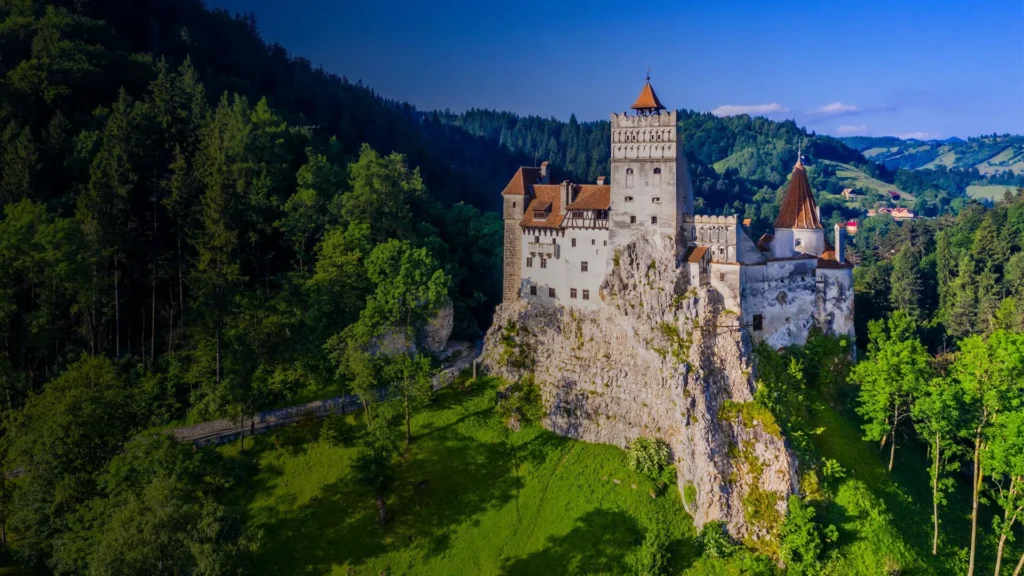
Image by bran-castle.com
Often associated with the legend of Dracula, this 14th-century fortress offers a spooky allure amidst the backdrop of the Carpathian Mountains.
Bran Castle, often associated with the legend of Dracula, is a striking medieval fortress perched high atop a cliff between Transylvania and Wallachia, in Romania. Constructed in the 14th century to protect against invading Ottomans, it flawlessly captures the essence of Eastern European medieval architecture with its towering turrets and imposing stone walls. Despite its vampiric legend largely fueled by Bram Stoker’s fictional Count Dracula, the castle’s real history is equally fascinating, having served as a royal residence and a military fortress.
The connection to Vlad the Impaler, the historical figure often linked to Dracula, is tenuous at best, yet the castle embraces this myth, adding to its mysterious allure. Inside, the castle unfolds as a maze of narrow, winding staircases leading to grand rooms filled with art, period furniture, and rich Romanian history. The atmosphere transports visitors back in time, offering a glimpse into the life of Romanian royalty, particularly Queen Marie, who is credited with its last major renovation.
Surrounded by dense forests atop the rocky cliffs of the Carpathian Mountains, Bran Castle’s stunning location feeds into its enigmatic reputation, drawing visitors from around the globe. It remains a testament to Romania’s rich cultural heritage and medieval history, bridging the gap between legend and historical reality.
14. Eltz Castle, Germany
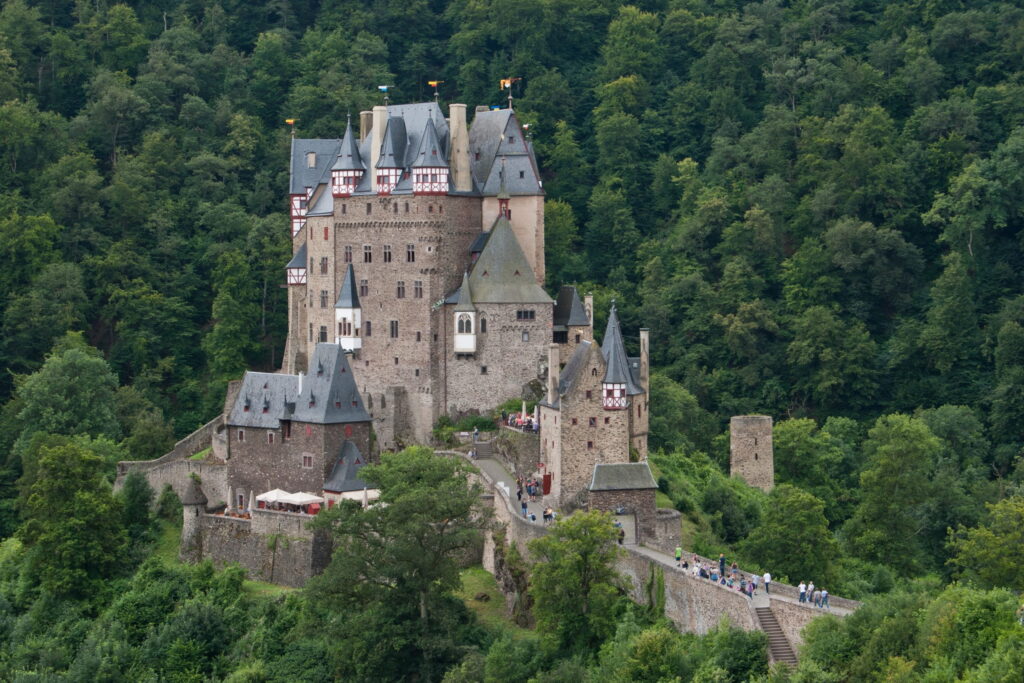
Image by Revisiting History
Tucked away in the hills above the Moselle River, this fairy-tale castle has been owned by the same family for over 850 years.
Eltz Castle, a majestic medieval fortress nestled in the heart of the Eifel region of Germany, seems plucked from the pages of a fairy tale. Towering against a backdrop of lush green forests, the castle has maintained its grace and architectural integrity since its inception in the 12th century. Distinguished by its unique position on a rocky spur, it is accessible via a winding path that cuts through the surrounding woods, enhancing its secluded and mysterious allure.
Owned and carefully preserved by the same family for over 30 generations, the castle presents an unrivaled journey through time. Unlike many European castles that have seen destruction and reconstruction over the ages, Eltz Castle has survived the tumults of history virtually untouched. Its architecture is a picturesque blend of Romanesque, Baroque, and Gothic styles, offering a diverse visual experience.
The interior of Eltz Castle is as impressive as its exterior, housing original furnishings, armors, and artifacts that reflect the rich history of the noble families who have resided there. Its treasury contains a stunning collection of medieval goldsmith work, alongside other precious items that underscore the castle’s historical significance.
Eltz Castle remains not just a monument of medieval architecture but a living museum, drawing visitors from around the world to marvel at its beauty and historical depth.
15. Schönbrunn Palace, Austria

Image by Vienna
A magnificent Baroque palace in Vienna, it was the summer residence of the Habsburg rulers and is renowned for its beautiful gardens.
Schönbrunn Palace, located in Vienna, Austria, is a magnificent symbol of the power and influence of the Habsburg monarchy. This sprawling baroque complex, with its history stretching back to the 17th century, was the summer residence of the Habsburgs, embodying the tastes, ambitions, and aspirations of this illustrious ruling family. The palace itself is a masterpiece of baroque architecture, featuring an impressive 1,441 rooms that exhibit the opulence and elegance of imperial times. The interiors, adorned with elaborate gold leaf, intricate stucco work, and grand frescoes, tell stories of a bygone era of extravagance and courtly life.
Beyond its stunning façade and luxurious rooms, Schönbrunn Palace is enveloped by vast and meticulously designed gardens, showcasing the baroque landscape architecture’s grandeur. The gardens are home to a myriad of attractions, including the famous Gloriette, a triumphal arch situated on a hilltop offering panoramic views of Vienna, and the world’s oldest zoo, Tiergarten Schönbrunn, founded in 1752.
Schönbrunn Palace is not merely a historical site; it is a cultural treasure that draws millions of visitors each year, eager to step into the opulence of the Habsburg legacy and explore the natural and architectural wonders of this UNESCO World Heritage site.
16. Bekal Fort
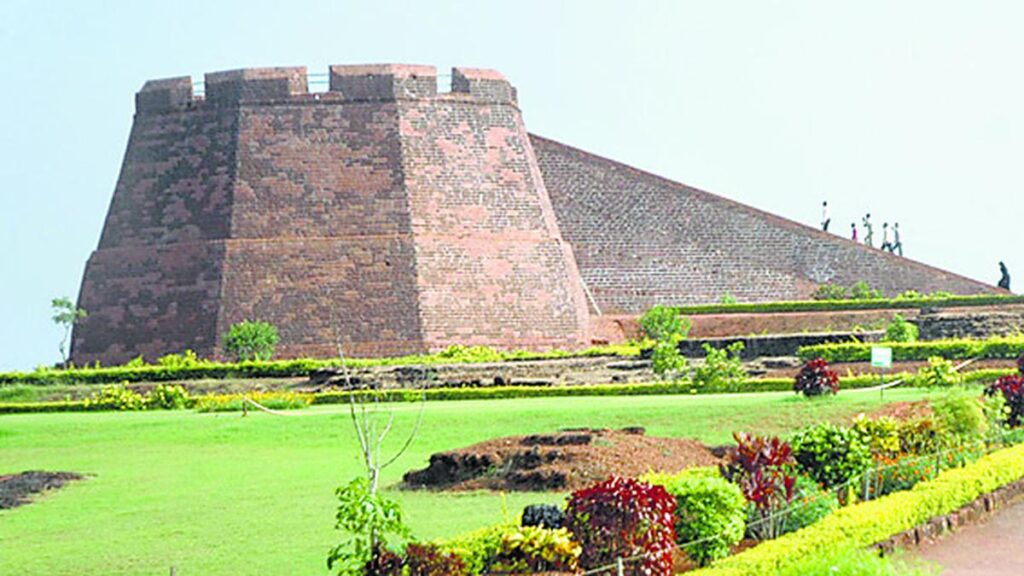
Image by The Hindu
Kerala: Set against the stunning backdrop of the Arabian Sea in Kerala, Bekal Fort is the largest fort in the state. Its keyhole-shaped perimeter, observation towers, and the mesmerizing views of the coastline make it a picturesque location that’s also been the shooting locale for various films.
Bekal Fort, a historic fortification, stands magnificently on the Western coast of Kerala, India. Surrounded by a beautiful beach, it paints a picturesque scene that captures the essence of Kerala’s rich cultural and architectural heritage. Built in 1650 AD by Shivappa Nayaka of Bednore, the fort spans over 40 acres, making it the largest fort in Kerala. Its strategic location at Bekal, Kasaragod, overlooking the Arabian Sea, was of great military importance in the past, primarily used to defend the region against invading forces.
The architectural design of Bekal Fort is unique, with its imposing circular structure, high walls, and a distinguished observation tower that offers panoramic views of the Arabian Sea. The fort’s keyhole-shaped entrance, tall observation towers, and the splendid view from its ramparts are worth noting, providing a glimpse into the military ingenuity of ancient Kerala. It also houses an ancient Hanuman temple and a mosque that add to its cultural significance, highlighting the religious harmony that existed in the region.
Today, Bekal Fort is a protected monument under the Archaeological Survey of India and has become a popular tourist destination, attracting visitors from all over the world. Its stunning location, historical importance, and architectural brilliance make it a must-visit for those exploring Kerala’s diverse attractions.
17. Predjama Castle, Slovenia
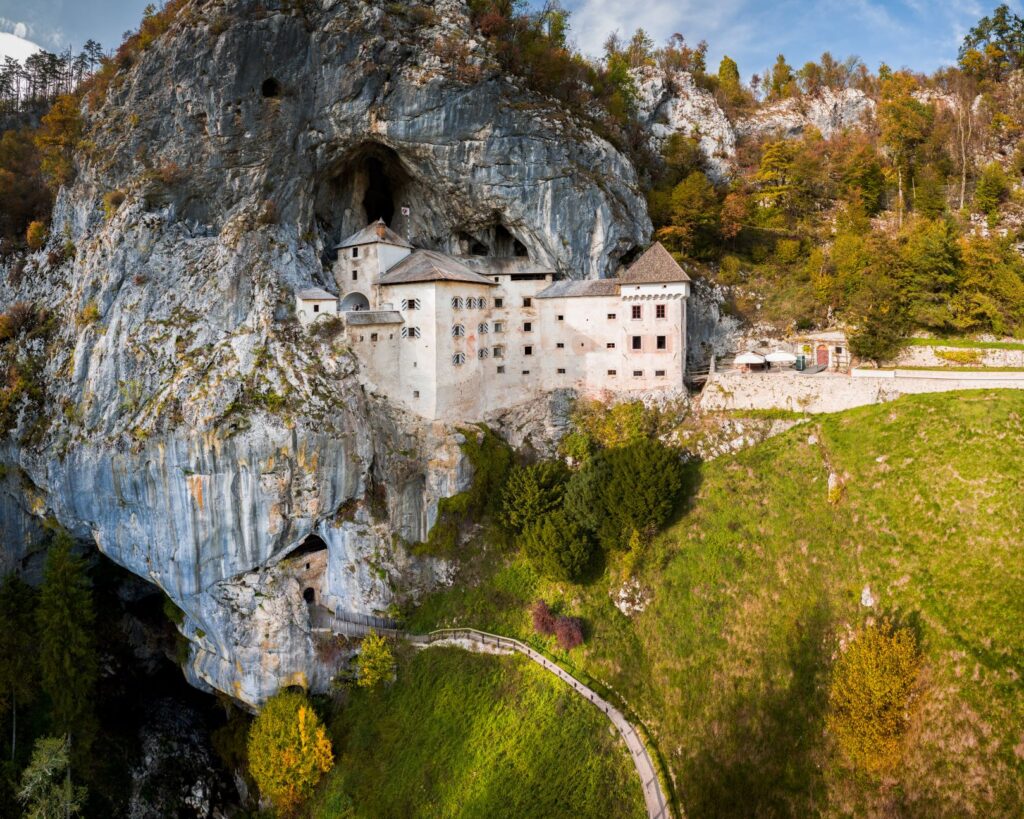
Image by Visit Postojna
This Renaissance castle built within a cave mouth offers a unique blend of natural wonders and architectural ingenuity.
Predjama Castle in Slovenia is not just a castle; it’s a breathtaking marvel of medieval architecture, seamlessly blending with the natural wonders that cradle it. Nestled in the heart of the Slovenian countryside, about 9 km from the town of Postojna, this remarkable fortress is perched in the middle of a 123-meter-high cliff for over 800 years, offering a vivid tapestry of human ingenuity and natural beauty. Its name, “Predjama,” literally translates to “in front of the cave,” which fittingly describes its unique location at the mouth of a cave system, integrating the man-made and the natural into a formidable stronghold.
The castle’s history is as dramatic as its setting. It was first mentioned in 1274, and its most famous occupant, Erazem of Predjama, a 15th-century knight who became a local Robin Hood, used the castle’s strategic position and the cave system behind it to hold out against besieging forces for over a year. Today, Predjama Castle stands as one of Slovenia’s most captivating tourist attractions, offering visitors a glimpse into a past wrapped in legend, innovation, and rebellion. Beyond its historical narrative, the castle is a testament to the medieval engineers who harmoniously blended fortification with the natural environment, creating not just a military stronghold but a piece of art that has stood the test of time.
18. Chillon Castle, Switzerland
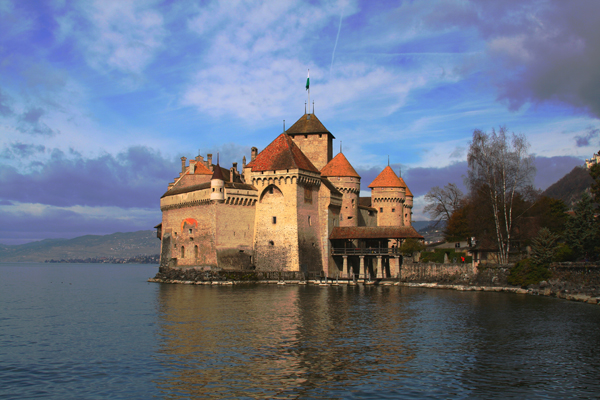
Image by WorldStrides
Located on the shores of Lake Geneva, Chillon is one of the most visited historic buildings in Switzerland, famous for its beautiful lakeside setting.
Chillon Castle, nestled elegantly on an island in Lake Geneva, near Montreux, Switzerland, stands as a testament to medieval architecture and history. This iconic fortress, dating back to the 11th century, has been an inspiration for poets and writers, most notably Lord Byron, who immortalized its beauty and history in his poem “The Prisoner of Chillon.” Its picturesque location, with the backdrop of the Alps and the tranquil waters of the lake, makes it one of Switzerland’s most visited historic sites.
The castle’s strategic position along the lake was crucial for controlling trade routes between northern and southern Europe, making it a vital possession for the Counts of Savoy who originally constructed it. Over centuries, Chillon has seen numerous modifications and expansions, reflecting changing architectural trends and the fortification needs of its inhabitants.
Walking through the castle’s halls, dungeons, and towers, visitors are transported back in time. Each room tells a story, from the grand banqueting halls to the somber, solitary confinement cells. Meticulously preserved artifacts and furnishings provide insights into the daily life and times of its historical residents.
Chillon Castle is not just a monument but a cultural treasure, embodying the rich heritage of Switzerland and the timeless allure of its landscapes. It continues to fascinate, drawing in those eager to explore its ancient stones and uncover the layers of history within its walls.
19. Chittorgarh Fort, Chittorgarh, Rajasthan
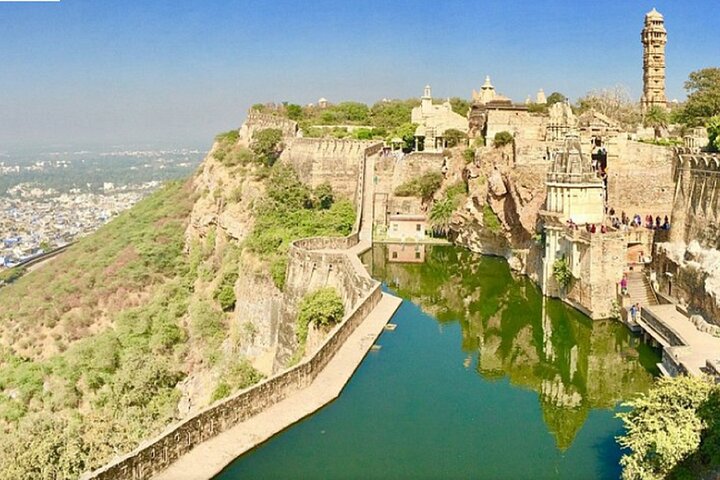
Image by Tripadvisor
Spread over 700 acres and claimed to be the largest fort in India, the Chittorgarh Fort’s might and beauty are unparalleled. It houses grand historical palaces, temples, and towers that boast of the Rajput gallantry. The fort’s architectural splendors, coupled with the tales of heroism and sacrifice, make it a compelling visit.
Chitradurga Fort, nestled in the heart of Karnataka, India, stands as a monumental relic of the country’s vibrant history. This iconic structure, also known as the “Stone Fortress,” lays perched on a series of rocky hills, overseeing the flat valley below with a majestic aura. Dating back to the 15th century, it was built by the rulers of the Vijayanagara Empire, but its legacy was further shaped by the Nayakas of Chitradurga, who expanded it into a formidable fortification.
The fort’s architecture is a testament to the ingenious engineering of the past. It comprises of seven concentric fortification walls, several imposing gateways, and intricate carvings that adorn the walls. Notably, its design incorporates the rugged topography into its defense mechanisms, making it virtually impregnable. The fort encompasses various historical structures within its confines, including temples, granaries, oil pits, and water reservoirs, highlighting the self-sufficiency of the fort’s inhabitants.
Chitradurga Fort’s lore is enriched with tales of valor and cunning, the most famous being that of Onake Obavva, a woman who single-handedly defended the fort against invaders, using a pestle (Onake).
Today, Chitradurga Fort attracts tourists and history enthusiasts alike, offering a glimpse into India’s glorious past and showcasing the architectural prowess and strategic acumen of its bygone era.
20. Castel del Monte, Italy

Image by ImaginApulia
A UNESCO World Heritage site, this 13th-century fortress in Apulia is known for its unique octagonal shape and mathematical and astronomical precision.
Castel del Monte, tucked in the picturesque Apulia region of southeast Italy, stands as an architectural marvel and a testament to medieval craftsmanship. Commissioned by the Holy Roman Emperor Frederick II in the 13th century, this octagonal castle is enveloped in mystery and allure, its precise purpose lost to time. Unlike typical fortifications of its age, Castel del Monte combines elements of military architecture with the elegance of a palatial residence, making it a unique relic of medieval history.
The castle’s design is a geometrical marvel; it is built as an octagon with each of the eight corners sporting an octagonal tower. This symmetrical precision aligns with cosmic symbols and mathematical harmony, leading scholars to speculate on its use for astronomical observations and as a symbol of imperial power. Inside, the layout is equally fascinating, divided into two levels with rooms designed to capture the sunlight at specific times of the day, illuminating the fine masonry and intricate details of its construction.
Declared a UNESCO World Heritage site in 1996, Castel del Monte attracts visitors from around the world, drawn to its enigmatic beauty and historical significance. It remains a proud symbol of Apulia, embodying the region’s rich heritage and the enduring legacy of Frederick II’s reign. Whether seen as a fortress, a hunting lodge, or a site of celestial significance, Castel del Monte continues to captivate and puzzle historians and tourists alike.
21. Conwy Castle, Wales
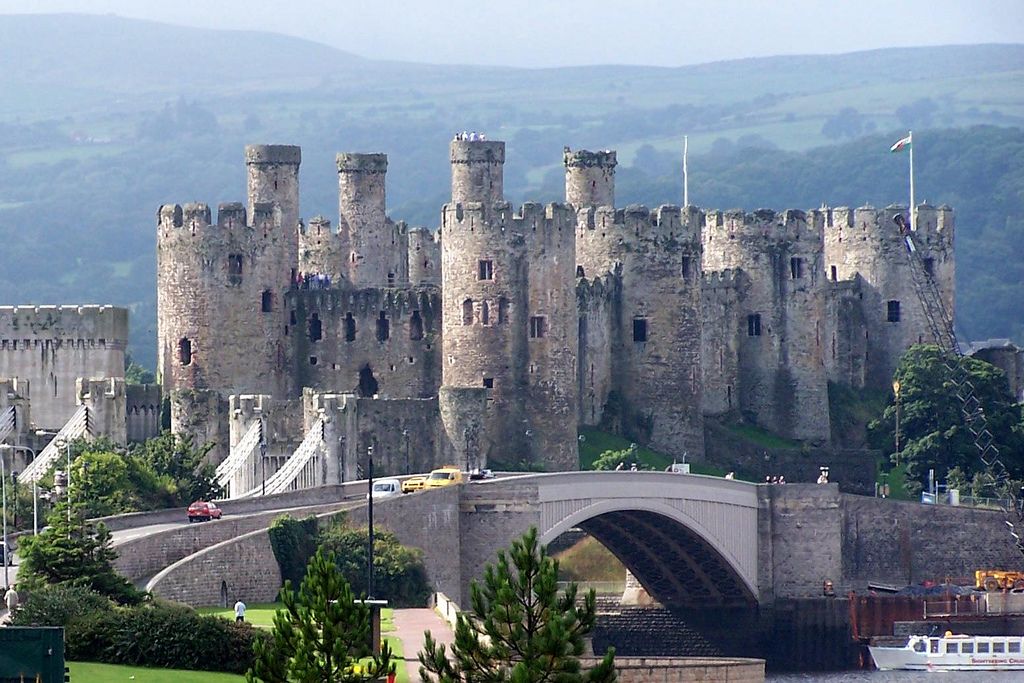
Image by www.fnh.edu.br
A sterling example of medieval military architecture, this castle boasts impressive towers and walls, offering stunning views of the surrounding landscape.
Conwy Castle, an emblem of medieval military architecture, stands majestically over the town of Conwy, Wales. Built by Edward I during his conquest of Wales between 1283 and 1289, the castle is a formidable symbol of English power, designed by the master castle builder James of St. George. Its location was strategically chosen, nestled on a rocky coastal ridge, with the River Conwy providing a natural moat, enhancing both its defense and its domination over the surrounding landscape.
The castle’s design is a testament to medieval engineering, featuring eight massive towers and two barbicans, offering formidable protection and a vantage point for archers. The walls, incredibly well-preserved, extend to envelop the town itself, showcasing one of the finest examples of medieval fortifications in Europe. Upon entering, visitors are transported back in time, as they walk through the great halls, private chambers, and royal apartments, imagining the lives of those who lived there centuries ago.
Conwy Castle’s significance transcends its military purpose; it is a cultural and historical beacon. Designated as a World Heritage Site, it represents the pinnacle of 13th-century military architecture and provides insight into the era’s socio-political dynamics. Its grandeur and preservation make it a must-visit, inviting people from all over the world to explore its walls and learn about Welsh history and heritage.
22. Trakai Island Castle, Lithuania
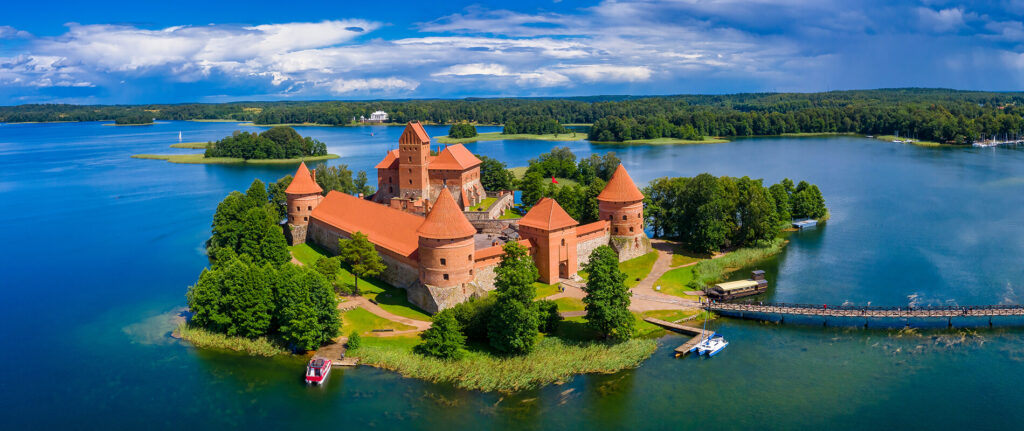
Image by MyBestPlace
This beautifully restored Gothic castle is located on an island in Lake Galvė, offering a serene and picturesque setting.
Trakai Island Castle, a majestic historical fortress, stands as an emblem of Lithuanian grandeur, nestled amidst the tranquil waters of Lake Galvė. This Gothic masterpiece, originating from the 14th century, was a tactical military stronghold and a regal residence for the Grand Dukes of Lithuania, especially under the reign of Kęstutis. The castle’s strategic location on an island made it a formidable defense structure against invaders throughout history.
Over the centuries, Trakai Island Castle has witnessed various phases of construction, destruction, and meticulous restoration, which has returned it to its former glory, making it one of Lithuania’s most cherished and iconic landmarks. The red-brick towers and walls of the castle, reflecting in the serene lake, create a picturesque scene that attracts visitors from around the world. Its architecture is a splendid representation of medieval Gothic style, featuring arched doorways, grand halls, and a striking drawbridge that serves as the entrance to this historical marvel.
Today, the castle operates as a museum, offering a glimpse into Lithuania’s rich history. Exhibitions within its walls display artifacts and tell tales of the past, from the grandeur of the Lithuanian Grand Duchy to the lifestyle of its inhabitants. Furthermore, Trakai Island Castle hosts various cultural events, medieval tournaments, and concerts, bringing history to life for modern audiences. This enchanting castle, surrounded by the natural beauty of Trakai Historical National Park, is not just a relic of the past but a living monument that continues to inspire and awe.
23. Mehrangarh Fort, Jodhpur, Rajasthan
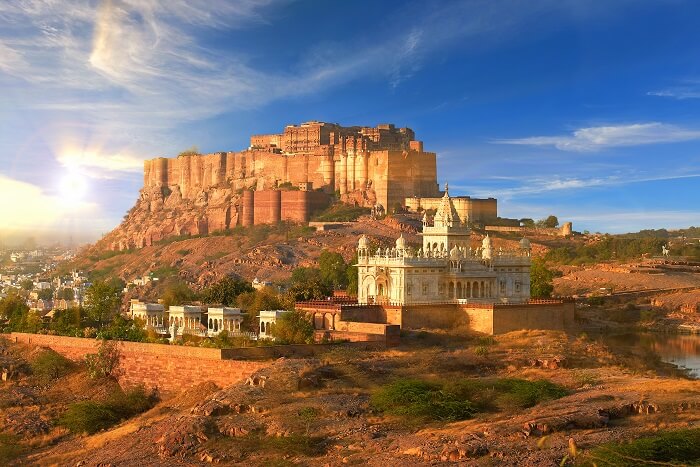
Image by Travelogy India
Perched on a 410 feet elevated hill and enclosed by imposing thick walls, Mehrangarh Fort is one of the largest forts in India. Its beauty lies in its grandeur and the intricate latticed windows, carved panels, and flamboyantly decorated walls of its palaces, including Moti Mahal, Sheesh Mahal, and Phool Mahal.
Mehrangarh Fort, perched atop a 410 feet elevated hill, dominates the skyline of Jodhpur, Rajasthan, with majestic grandeur. This architectural masterpiece, built by Rao Jodha in 1459, is one of India’s largest and most formidable forts. Its imposing walls, which appear invincible and imposing, tell tales of bravery, battle, and the rich history of the Rajputs.
As you navigate through its seven gates, each erected to commemorate a victory over invading armies, the fort unfolds its historical layers. Inside, the fort complex houses several palaces, each adorned with intricate carvings and expansive courtyards, reflecting the grandeur of Rajputana architecture. Notable among them are the Phool Mahal, Sheesh Mahal, and Moti Mahal, each offering a glimpse into the royal lifestyle of the past.
Mehrangarh Fort also hosts a well-maintained museum that showcases a splendid collection of royal palanquins, costumes, arms, paintings, and decorated rooms. The fort, with its breathtaking views of the blue city of Jodhpur below, presents a striking contrast between the rugged fortifications and the delicate artistic endeavors inside. Mehrangarh, a testimony to the splendor of India’s royal heritage, remains a profound symbol of Rajput pride and valour.
24. Kylemore Abbey, Ireland
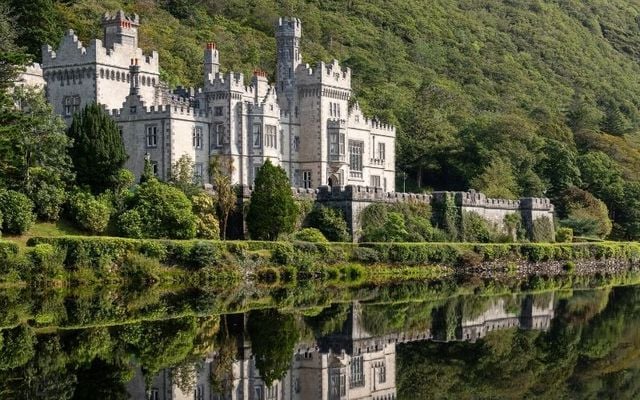
Image by Irish Central
Originally built as a castle, this stunning estate in Connemara is now a Benedictine monastery known for its Victorian walled garden.
Kylemore Abbey, nestled in the heart of Connemara, County Galway, Ireland, is a beacon of history, beauty, and architectural marvel. Originally built as a private home in 1867 by Mitchell Henry, a wealthy businessman from Manchester, England, for his beloved wife Margaret, the castle epitomizes romantic elegance amidst rugged landscapes. Spanning approximately 40,000 square feet, it showcases Victorian craftsmanship and is circled by lush gardens and tranquil lakes, offering breathtaking views of the Connemara National Park.
The estate’s history took a spiritual turn in 1920 when it became home to the Benedictine nuns who fled Belgium during World War I. They established a monastery within the castle, continuing a legacy of education and spirituality. The Benedictine community founded a girls’ school, which operated until 2010, further embedding Kylemore Abbey into the fabric of local and national heritage.
Today, Kylemore Abbey serves as a tourist attraction, offering visitors a glimpse into its storied past. The Victorian Walled Garden, restored to its original 19th-century splendor, spans six acres and is a horticultural masterpiece showcasing the ingenuity of past generations. The Gothic Church, a tribute by Mitchell Henry to his late wife, stands as a testament to enduring love and faith, drawing visitors from around the world. Through its compelling blend of natural beauty, history, and architectural significance, Kylemore Abbey remains an iconic symbol of Ireland’s cultural landscape.
25. Chateau de Versailles, France

Image by PlanetWare
Versailles is more than a castle; it’s a symbol of the absolute monarchy of the Ancien Régime, with its Hall of Mirrors and expansive gardens.
The Chateau de Versailles, located in the Île-de-France region of France, stands as a monumental symbol of the absolute monarchy of the Ancien Régime, with its origins dating back to the reign of Louis XIII in the 17th century. Initially constructed as a hunting lodge, it was transformed by his son, Louis XIV, also known as the Sun King, into a magnificent palace that served not only as his home but as the seat of France’s government for over a century.
Versailles is an architectural masterpiece, showcasing the grandeur of classical French architecture, with its intricate designs and lavish decorations. The palace’s Hall of Mirrors, the Grand Apartment, and the royal chapel are some of its most renowned features, each telling a story of power, politics, and artistry. The gardens of Versailles, equally famed, are a testament to landscape engineering, with perfectly manicured lawns, sculptures, and spectacular fountains spread across 800 hectares.
Beyond its beauty, Versailles has been a site of significant historical events, including the signing of the Treaty of Versailles in 1919, which ended World War I. Today, it serves as a museum of French history, attracting millions of visitors from around the world, drawn to its opulence, history, and the insights it offers into the era of kings who dreamt of embodying the glory of France in stone and gardens.
26. Amber Fort, Jaipur, Rajasthan
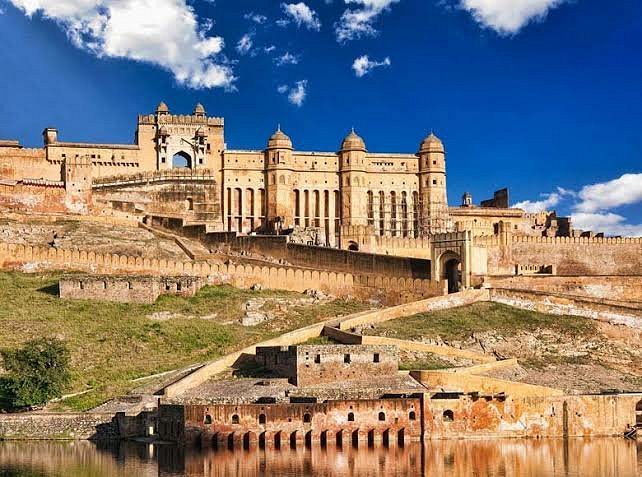
Image by Tripadvisor
Built in the 16th century by Raja Man Singh, this fortress-palace lies atop a hill and is renowned for its artistic Hindu style elements. The fort’s red sandstone and marble exterior is majestic, and its interiors are equally opulent, with the Sheesh Mahal or Palace of Mirrors being a highlight.
Amber Fort, an exquisite blend of Hindu and Mughal architectural elements, stands as a magnificent testament to India’s rich past in Jaipur, Rajasthan. Nestled atop a hill, the fort overlooks the Maota Lake, adding a serene beauty to its rugged exterior. Built in 1592 by Maharaja Man Singh I, it is made primarily of red sandstone and marble, sprawling across a rugged terrain, accessible via a scenic uphill path that can be traversed on elephant back, replicating the royal experience of yesteryears.
The fort complex is a treasure trove of artistic craftsmanship, with its sprawling courtyards, majestic gates, and elaborately decorated halls. The Diwan-e-Aam (Hall of Public Audience) and the Diwan-e-Khas (Hall of Private Audience) showcase the intricate workmanship, with their stunning pillars and mosaic work. The Sheesh Mahal (Mirror Palace) is a masterpiece, with walls and ceiling adorned with thousands of mirror tiles, creating a mesmerizing effect. The Sukh Niwas (Pleasure Palace) demonstrates an early form of air conditioning, with water flowing through a clever channel system to cool the surroundings.
Amber Fort is not just a monument; it’s a narrative of the glorious past, embodying the spirit and the architectural brilliance of the Rajputana era. It remains a symbol of Rajasthan’s history, attracting travelers worldwide with its timeless allure and showcasing the cultural heritage of India.



























